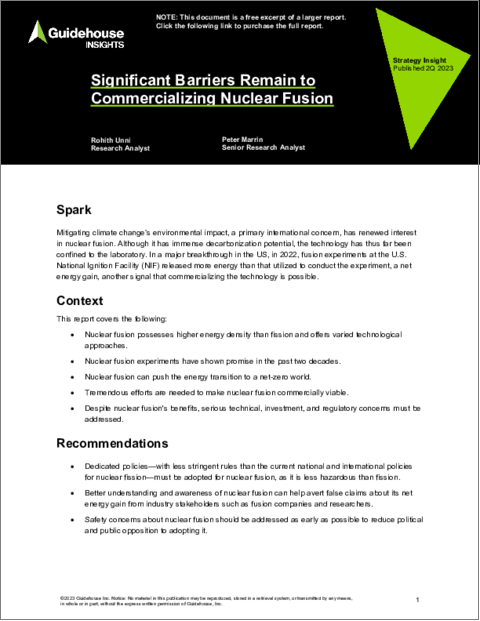|
|
市場調査レポート
商品コード
1296109
核融合の商業化:巨大な障壁の残存Significant Barriers Remain to Commercializing Nuclear Fusion |
||||||
|
|||||||
| 核融合の商業化:巨大な障壁の残存 |
|
出版日: 2023年06月21日
発行: Guidehouse Research
ページ情報: 英文 15 Pages; 4 Tables, Charts & Figures
納期: 即納可能
|
- 全表示
- 概要
- 図表
- 目次
世界の一部の地域では、持続的な経済成長に十分なエネルギー供給を行いつつ、CO2排出量の大幅削減を達成するための明確な戦略の策定に苦慮しています。世界気象機関は現在、21世紀末までに世界の気温が3度から5度上昇すると予測しています。この予測は、2.0度の地球温暖化目標や、より野心的な1.5度の目標を達成するためには、現在の努力だけでは不十分であることを示唆しています。
核融合は無尽蔵のエネルギー供給源であり、解決策となり得ます。この技術を現実のものとするべく、世界各国で多大な努力が払われていますが、経済的にはまだ実現不可能であり、商業化もされていません。有望な国際熱核融合実験炉 (ITER) プロジェクトが成功したとしても、原子炉の正味エネルギー利得と平準化電気料金 (LCOE) を考慮すると、この技術が経済的に競争力を持つ保証はありません。核融合が競争力を持つためには、グリッドパリティを達成する必要があります。つまり、LCOEが送電網の電力価格と同等か、それ以下の状態となる必要性があります。
当レポートでは、核融合技術の実用化に際して克服すべき様々な課題について分析し、グリーンエネルギー需要の増大に取り組むための核融合の重要性や、各種の技術的アプローチの概略、核融合産業における最近のブレークスルー、長年の努力にもかかわらず核融合が実現しない理由、取るべき主な対応策 (民間・公的資金による核融合産業の財政的支援など)、主な利害関係者への重要な提言、といった情報を取りまとめてお届けいたします。
目次
序文
背景
提言
核融合:エネルギー転換分野での関心増大
核融合反応:開発された4種類のアプローチ
磁気閉じ込め方式
慣性閉じ込め方式
磁化標的核融合
ハイブリッド式核融合
数十年にわたる調査の末の、近年の画期的な進歩の実現
努力にもかかわらず、核融合はまだ商業的に実現可能ではない
核融合エネルギー:ネットゼロ目標の達成のために迅速に行動する必要性
官民資金による核融合研究開発の活性化
公的資金
可能性があるにもかかわらず、核融合エネルギーは複数の面で課題に直面している
技術的課題の克服:核融合成功の鍵
投資家の視点
核融合を促進のために、規制上の懸念が緩和される可能性
核融合産業:核融合について国民を教育する必要性
規制当局:核分裂施設と核融合施設の違いを考慮する必要性
List of Tables
Advantages and Disadvantages of Nuclear Fission
List of Figures
Nuclear Fusion
Reactor Energy Gain in Nuclear Fusion
Some world regions are struggling to develop clear strategies for achieving substantial CO2 emissions reductions while providing energy supplies sufficient for sustained economic growth. The World Meteorological Organization currently predicts that global temperatures will increase by 3° C to 5° C by the end of the 21st century. This projection suggests that current efforts may not be enough to achieve either a 2.0‑degree global climate target, or the more ambitious 1.5-degree goal.
Nuclear fusion offers an inexhaustible supply of energy and could be a solution. Enormous global effort is going into making the technology a reality, but it is still not yet economically feasible and has not been commercialized. Even if the promising International Thermonuclear Experimental Reactor (ITER) project is successful, the technology is not assured of being economically competitive, considering the reactors net energy gain and the levelized cost of electricity (LCOE). For nuclear fusion to be competitive, it must reach grid parity, which only happens when its LCOE is equal to or below the price of power on the grid.
This Guidehouse Insights Strategy Insight reviews the significance of nuclear fusion in tackling the growing demand for green energy. It explains the differences between nuclear fission and fusion and looks at various technology approaches, recent breakthroughs in the fusion industry, and its persistent lack of traction, despite decades of effort. The study also examines the industry's financial support from private and public funding, its major challenges, and offers key recommendations for stakeholders.
Table of Contents
Spark
Context
Recommendations
Nuclear Fusion Gains Traction in the Energy Transition
Four Approaches Have Been Developed for Nuclear Fusion Reactions
Magnetic Confinement
Inertial Confinement
Magnetized Target Fusion
Hybrid Fusion
Recent Breakthroughs Came after Decades of Research
Despite Efforts, Nuclear Fusion Is Still Not Yet Commercially Viable
Fusion Energy Must Move Quickly to Aid Net-Zero Goals
Public and Private Funding Vitalized Nuclear Fusion R&D
Public Funding
Despite Its Potential, Fusion Energy Faces Challenges on Multiple Fronts
Overcoming the Technical Challenges Is Key to Nuclear Fusion's Success
Investors' Perspectives
Regulatory Concerns Could Be Loosened to Encourage Nuclear Fusion
The Fusion Industry Must Educate the Public about Nuclear Fusion
Regulators Must Consider the Differences between Fission and Fusion Facilities






